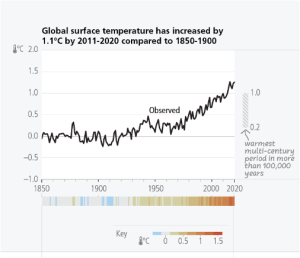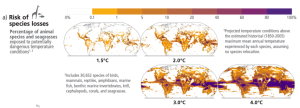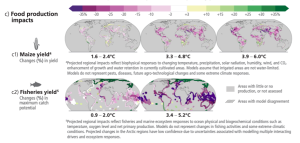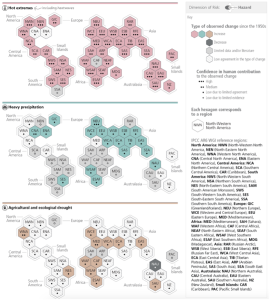27 The Future of Climate Change
gcalpito
The Future of Climate Change
The future of climate change is in our hands because it is being driven by our hands. Through activities such as burning fossil fuels, deforestation, industrial progress, and the use of chemicals, our world has gone through changes that now reach beyond environmental challenges. From all over the world, different regions are feeling the new consequences of human action that has caused a rise in global temperatures, shifted weather patters, and rising sea levels. It is through the understanding of the future implications of climate change in our environment that we will be able to shape policies and actions to be able to mitigate their effects. (GC)

Environmental Impacts
The IPCC, or the Intergovernmental Panel on Climate Change, is an intergovernmental organization established in 1988 by the World Meteorological Organization (WMO) and the United Nations Environment Program (UNEP). It is able to help provide policymakers with scientific assessments on climate change, the implications, and what the potential future risks are. IPCC then releases its findings through a synthesis report, which is available to the public. (GC)
The following information will be from the IPCC’s AR6, which was published in 2023. This is the most recent comprehensive scientific report on climate change conducted by the IPCC. (GC)
Rising Global Temperatures

Global warming is when there is an increase in both the surface sea and air temperatures. Figure 1 shows that the average surface temperature has increased by 1.1 degrees Celsius since the pre-industrial era (1850-1900). There is also an exponential growth since the 1950’s due to the industrial revolutions In 2024, we had expected it to be the warmest year in a global level. It was recorded that global temperatures were 1.1 degrees Celsius higher than the 20th-century average. The rise of global temperatures due to human actions. (GC)
Transitions to a renewable energy, wind, solar, hydro, and geothermal that are able to decrease the burning of fossil fuels. The increase to efficiency enhancing technology, transportation, and manufacturingto be able to reduce the amount used for electricity which then cuts emissions from powerplants. And the the creation and enforcement of carbon pricing and emission regulations which causes companies to lessen their emissions for the benefit of not spending extra money to pay and to invest in more “green alternatives”. (GC)
Rising Sea Levels
Alongside the rising global temperatures, ocean levels have also been rising. It has risen by 20 cm from 1901 to 2018, with the rate of the rise having accelerated in the previous decades due to the melting of the ice sheets and glaciers, specifically the the Greenland and Antarctic ice sheet. The rise of sea levels is expected to pose risks to coastal and lower-lying region ecosystems and populations. Certain infrastructural adaptaion and the creation of coastal defenses such as storm barriers, elevated buildings, or ocean wall are able to prevent further damage to certain areas from events such as flooding. (GC)
Warmer Oceans
Alongside the rising sea levels, the temperature of the ocean has also risen. 90% of the excess heat that is made by human actions has been absorbed by the ocean since 1970, the effect is the warming of the ocean, acidification, and deoxygenation. The warming oceans also play a variable in the rising sea levels since they are a factor that causes the melting of glaciers and ice sheets. To compare with the rise of global temperatures, oceans are warming at a slower pace. (GC)
Overall, the best way to mitigate this issue would be to reduce greenhouse gas emissions through similar ways talked about in the section of rising global temperatures. Through those actions, the amount of heat that is trapped in our oceans would be reduced and therefore help slow down the heat absorption. The restoration and protection of coastal ecosystems because it can allows ecosystems to grow and recover which can then help against ocean acidification and temperature changes.(GC)
Extreme Weather Events
Climate change is intensifying the global water cycle, leading to more frequent and severe extreme weather events, such as heat waves, droughts, floods, and storms. These events increase existing vulnerabilities and create a risk that to the human population and their environment. (GC)
Infrastructure changes that can be made to help mitigate some of the damages done. The upgrade of things such as power grids, stormwater systems, and flood barriers are able to help a population withstand damaging weather events. Technological changes are also able to help because of how it can give a longer preparation time to a possible disaster and just overall be more prepared for one. (GC)
Biodiversity Loss
Climate change is driving the loss of biodiversity through habitat loss, species range shifts, and increased risks of species extinction. We can see these ty

pes of impacts more in regions with sensitive ecosystems like coral reefs, Arctic regions, and tropical rainforests. Figure 2 from the IPCC Synthesis Report shows us the risk of future species losses based on the rise of global temperatures. We can see that the increased rise of temperature by 4.8 degrees celsius will affect species all over the world. In comparison to how the current state mainly affects those in coastal areas.
Protection of certain areas and restoration of habitats are able to help save the critical habitats to allow for the species living in them, to be able adapt and possibly be able to increase their population. This is specifically important to the coastal areas that are already now getting affected, for the possibility that we would able change before the it reaches an amount that we will not be able to recover from. (GC)
Closing Statement
The IPCC is able to provide detailed assessments of climate change for topics other than the “scientific”, but also what the causes and impacts are, and what the possibilities are for different forms of solutions. Overall, it assigns the reason for global warming is because of human activity, which includes activities such as deforestation and the use/ burning of fossil fuels. They support this claim by using evidence such as the rise of global temperatures and sea levels. They also monitor regional effects, and from that, they have discovered an increase in the frequency of events such as heat waves, the spread of disease, reduced crop yields, and a continuous threat to the ecosystem. These regional effects often lead to larger issues, which will be explained in future sections. (GC)
The IPCC is able to outline adaptation strategies such as emergency planning and improved infrastructure. To add, they also have mitigation strategies to prevent or lessen the effects, such as renewable and more efficient energy, and carbon pricing. They take into consideration the different rates of global development and disparities and acknowledge the importance of climate justice. They take into account that low-income populations and future generations have higher risks. The IPCC is a great source of information to understand climate change and how to respond to it. (GC)
Human and Societal Impacts
It is not just the environment that will be affected by climate change, the Earth’s population will also experience the consequences of climate change, both directly and indirectly. The changes in the Earth’s environment will affect and increase the consequences for the population . (GC)
Food and Water Scarcity

From the environmental effects above, there is a direct impact on the supply of both food and water. The changes of rising temperatures, changes in precipitation patterns, and the increased occurrences of weather events can lead to reduced crop yields and therefore negatively affect the supply of food production. The weather changes can also affect the environment in the growing regions. It would lead to these regions being unable to sustain the growth of the crops. The warmer oceans and acidification can negatively affect marine ecosystems, leading to reduced fish stocks and threatening food security for populations reliant on seafood (Munir). (GC)
Water scarcity is the insufficient access to freshwater resources to meet the human and environmental demands of a given area/ population (Petruzzello). The effects of climate change alter the water security of populations and environments. The melting of the glaciers due to the rise in temperatures can disrupt freshwater supplies. The rise of sea levels can lead to saline intrusion, which reduces freshwater availability. In addition to water scarcity, the possibility of toxic metals, such as arsenic and lead from factors such as industrial waste and also natural causes such as mineral deposits and runoffs, that are able to contaminate the water sources (Gosling). All of these affect the supply of the produce required for human consumption, the disrupted supply chains can lead to higher food prices, making it more challenging for vulnerable populations to access adequate nutritional foods. (GC)
The development of certain crop varieties that are drought resistant and are able to withstand higher temperatures can help keep the food production at a steady pace while there are changes in the climate. Similarily, investing in healthy fishing practices and the creation of a more climate resilient aquaculture allows to have fisheries and aquacultures to have steady production. (GC)
Forced Migration
Forced migration is the involuntary movement of people from their homes or places of habitual residence, often due to factors beyond their control, such as armed conflict, natural disasters, or environmental degradation. This movement can occur within a country or across international borders. They can be the effects of extreme weather events, which have an increase of occurrence and severity, rising sea levels, and crop failure. This is a result of the extreme weather events because of how it can damage the homes and infrastructure of the community and therefore force them to move to be able to support themselves (Huang). The rise of sea levels mostly affects those who are in coastal areas or those living on an island due to flooding. Failed growth of crops can also lead to forced migration since there are not enough resources available at the location to be able to support a community. (GC)
Societal Inequalities
The societal inequalities will be exacerbated. Due to the changes in the supply and price of food, water, and housing, and an unchanging demand, shortages will appear. These shortages of various resources will directly affect those in communities that live directly in the environment or those in poverty . Those who are seen as “better off” or have more access and ability to access resources are the ones who are affected last. The Intergovernmental Panel on Climate Change (IPCC) Third Assessment Report concluded that climate change is projected to increase threats to human health, particularly in lower-income populations, predominantly within tropical/subtropical countries (EBI). Examples of these threats would be, as said before, food and water scarcity, increased risk of diseases, and displacement. The climate crisis puts an increase in global inequality and injustice and we are able to see this because of how it disproportionately affects those who have limited access to resources and are less adaptable to the changes in their current environment. (GC)
Climate Justice
Climate justice addresses the ethical, social, and political dimensions of climate change, focusing on the disproportionate impacts that climate change has on different populations, particularly those that are vulnerable and marginalized (Schlosberg). (GC)
Public Health
The impact of climate change on the overall state of public health varies. From the possibility of the reemergence and spread of disease, the changes in air quality and rising temperature, to the state of a person’s mental health climate change can be seen affecting us all in a variety of ways. (GC)
Disease
Climate change is contributing to the emergence and re-emergence of infectious diseases. Because of the changes in the environmental conditions, it has allowed for vector-borne diseases to be increased. The figure shown, it shows an increase in reported cases of tick-borne diseases. The increase of these cases can be also be attributed to reforestation strategies, and the growing population of deer, which are hosts for ticks, and the expansion towards areas that are in the woods (Stone). Overall, whether it be ticks or mosquitoes, the reemergence or diseases and the increased frequency of cases are a consequence of the ecological changes of climate change and certain mitigation strategies. (GC)
Air-Pollution
Another significant impact of climate change is the deterioration of air quality. Rising temperatures can enhance the formation of ground-level ozone, which a major component of smog. The increased air pollution from particulate matter and other airborne contaminants is linked to climate change and poses serious health risks. These include respiratory and cardiovascular diseases, and in extreme cases, premature death (Meier). (GC)
Rising Temperatures
Rising global temperatures, another aspect of climate change, lead to an increased frequency of heat waves, which pose health risks such as heatstroke and dehydration. Also, chronic exposure to high temperatures can increase the existing cardiovascular and respiratory diseases that a person may already have. This is particularly dangerous for certain populations like the elderly, children, and those with preexisting health conditions (Meier). (GC)
Mental Health
The effects of climate change extend beyond physical health, also affecting mental well-being. The stress of living in areas increasingly affected by severe weather events such as hurricanes, floods, and wildfires can lead to mental health issues. These can include anxiety, depression, and post-traumatic stress disorder. Moreover, the existential threat and uncertainty of climate change contribute to chronic stress and anxiety, a phenomenon commonly referred to as eco-anxiety or climate anxiety (Meier). (GC)
Economic and Political Challenges
Agriculture
Agriculture is able to affect the economic and political climate because it is a necessary product in human consumption to be able to function. Due to the changes of climate change, such as the increased temperatures (both land and water) and the increased weather challenges, there is a reduced crop yield, lessened crop sustainability, and an increased risk for disease and pest outbreaks (Buldafosen). Changes in the supply of agriculture can lead to shortages in food, which then increases the prices. Economically, this will raise the overall prices of the goods, which will cause a strain on the economy since food is a necessary resource. (GC)
The overall instability of the agricultural industry threatens the livelihoods of a large percent of the population, specifically those residing in rural areas since agriculture is most likely their main source of income, both personally and in their community. The risk of unemployment is increased the more the unstable the agricultural context is. This can further lead into Governments taking action to be able to protect both the economy and the public. Some of the actions the Government can take is to increase programs specifically targetting those who are food insecure, create stricter price controls, and to create price ceilings. Yet these actions can change and cause a strain on the national budgets, which may decrease the economical power and therefore may shift their political priorities. (GC)
Infrastructure
Another part of our society that is affected by climate change is our infrastructure. Things such as roads, buildings, etc., can be negatively affected in the face of extreme weather events, which, was stated before, have had an increase in frequency and severity. Damages to infrastructure can also lead to the damages of specific services needed to be able to have a functioning society, things such as electricity, a clean water supply, communication networks etc. are all unintended consequences to infrastructural damages. The economic and political challenges we face in terms of infrastructure would be the costs that involve having to rebuild broken or damaged infrastructure and to be able to create/ design new structures that are more resilient to climate challenges (Kumar). (GC)
Damages to infrastructure can also show the inequalities that certain populations may face, en example would how a rural community has less resources (money and people) to be able to recover at the same rate as a community in a major city. (GC)
Transition to a Green Economy
Finally, the transition to a green economy presents its own set of challenges. Moving away from fossil fuels towards renewable energy sources, improving energy efficiency, and cultivating new, environmentally sustainable economic sectors require substantial economic adjustment. To be able to make large-scale changes like these, it is necessary to have the supportive financial backing to be able to provide these changes. To add, the creation of these changes will also disrupt the current systems, systems that although harming the environment, are known to be effective to be able to in growing economic power. Changes in workforces, specifically for those in the industries that are reliant on fossil fuels, have a large disadvantage due to how they need to create a change in their programs. (Buldafosen). (GC)
Overall, there is a challenge to manage the short-term and long-term trade offs. For te short-term, it requires high financial investments, which is seen as unhelpful in communities who have based their livelihoods on the fossil fuel based industries. In comparison, the long-run is able to provide the benefits of renewable energy, things such as less environmental harm and reduced operational costs. (GC)
Ethical Question and Education
There are many ethical questions that surround climate change. From the topic of global inequality to the moral responsibility of either the individual or the Institution, we will explore them and how they intertwine with the future of climate mitigation and prevention. (GC)
Responsibility for Emissions

The responsibility for emissions refers to the amount of greenhouse gases each respective country has emitted. High-income, industrialized countries like the United States, much of Western Europe, and China are among the largest contributors to global emissions, both in terms of total output and historical accumulation since the Industrial Revolution. (GC)
This imbalance matters because while the effects of climate change are global, they disproportionately impact low-emitting, less-developed countries that often lack the resources to adapt. As a result, international climate agreements like the Paris Agreement emphasize the principle of “common but differentiated responsibilities,” meaning all countries must contribute to climate action, but those with greater historical emissions and more economic capacity are expected to take the lead. High-emitting countries are also expected to provide financial and technological support to lower-income nations to help them transition to clean energy and build resilience. If major polluters fail to act, it can erode global cooperation and reduce the willingness of developing nations to commit to ambitious climate goals. Ultimately, acknowledging and addressing the unequal responsibility for emissions is essential to ensure fairness and effectiveness in global climate change mitigation. (GC)
Economic and Environmental Priorities
Internationally, no nation/ country grows at the same rate. Those who are in developing countries face larger issues with balancing their economic growth without “letting down” their environmental sustainability. High-income countries are more likely to have resources to invest in clean technology, but it is also these countries that have a reliance on fossil fuels to grow their industries and therefore grow economically. In comparison, those who are in lower-income nations are at a loss due to how they already little economical power and ability to automatically use green practices (Kumar). These all contribute to challenges in climate negotiations, it is often argued about which countries should “pay more”, “increase green efforts”. In previous sections, we had talked about the international agreements, and it is the economic and environmental priorities are dependent on how all nations must act to create a difference but also stay within their capabilities and previous contributions. (GC)
The Paris Agreement has the idea of “common but differentiated responsibilities”, which seeks to enforce that all countries should take action in climate change, but also understanding that developed countries should take a lead due to their cumulative emissions. (GC)
Tragedy of the Commons
The tragedy of the Commons is when individuals act in their own individual interest and satisfaction, which leads to a depletion of a common resource and ultimately leads to harm to the population and the environment. Overconsumption of our current resources is the reason why climate change has increased in comparison to previous centuries. The Earth’s resources are continuously and steeply sourced, and this overconsumption with the inability to replenish them as quickly, is what leads to the quick and large depletion of the resources. Which in the long run ruins the ability to work in the population’s self-interest and the sustainability of the resources. (GC)
A way to mitigate or avoid the tragedy of the commons is to involve a majority of nations in implementing regulation and oversight on the resource. This would then lead to more control of the amount of the resource and the supervision of its sustainability. While it will lead to a smaller individual satisfaction in the short term, in the long run it will lead to a higher societal satisfaction. (GC)
Change in Human Behavior
Education plays a critical role in addressing climate change. Traditionally, education has prioritized capitalist values over sustainability, which has produced values that an industrialized economy holds more importance than the negative environmental impacts that is the consequence. Overall, there is a lack of integration of climate change in our education, even though there is an increase in awareness through other platforms such as social media. (GC)
A qualitative study conducted by J.M. Martin-Kerry at the University of Leicester investigated, through interviews and surveys, the perception of people towards climate change and how it may affect them and their health. It was concluded that although people were concerned. Yet it is most of the people who participated who did not believe that climate change has been affecting their life and their health (Martin-Kerry). (GC)
Education of current and future generations is significant for the preparation of the ability to address the multifaceted issue that is intertwined with climate change. Public education campaigns and policy funding are ways to be able to “fund” the the climate education and makes sure that it is included nationally in educational curriculums. This would allow for the continuing population to be informed about the causes and impacts of climate change for them to be able to understand. The role of policy and educational reform is important because for these changes to be made, there has to be a change in revising the curriculum and policy. (GC)
The effects of climate change is all around for us to see, hear, and feel. From the global, human, societal, public health, economic, and political impacts, it is hard to see an aspect of our lives that is not affected by climate change. Evidence from global research already shows much climate change has changes our Earth in the short amount of time, but also that its disproportionately affecting different populations. Through the changes that we create based on our knowledge of climate change, the prevention and mitigation plans can be put in place. Mitigation actions must be planned accordingly with the future goals and for them to be attainable. The efforts and education of everyone, including you and me, are often the kick-start for the enactment of change. (GC)
Total Word Count: 3911
Reflection Word Count: 701
